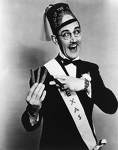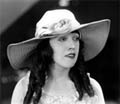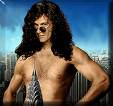










|
Comedies have had a very interesting life cycle in the movies. The studios started making short comedies in early 1900's. Most of those studios such as Keystone, Mutual, Biograph and Mack Sennett do not exist any more. Remember that in the early days of movies and all the way until 1927, there was no sound. Also, as we have said elsewhere, there was no close-up shot used until much later. So, the comedians had to make you laugh by creating hilarious animated situations. That is the reason Keystone cops used to be so fast and crazy running in and out of their wagon. You also saw an actor dangling from a clock on top of a high rise building or hospital patients, inhaling helium and floating through the air. Submit your Comedy Review. To be successful, a comedian had to be real good at miming with his body. That is why unlike today when many actors can play comedy and drama roles, comedians of the silent era were a breed apart. Some of the early comedians who were famous and really talented were, Charley Chase, Edgar Kennedy, Harry Langdon, Harold Lloyd, Ben Turpin, Buster Keaton and Charley Chaplin. There were not that many female comedians then, because it was thought unladylike to engage in acrobatic exercises to get a laugh like the men did. The two most famous female comedians were Edna Purviance and Mabel Normand. Mabel Normand directed several movies. She even directed Charlie Chaplin. Mabel was a beautiful woman with dreamy eyes, full lips and a little upturned nose. But she had that something that made her appealing to millions of fans. Mabel lived a fast and full life. Her name was associated with several homicides and she was known to drink and take drugs. She died at the age of 37 from tuberculosis Some interesting facts about the early comedians. Ben Turpin used to be the highest paid performer in the 1910's. He used to get $3000.00 a week and he used to stop passers by in the street and boast about his salary. He had also insured his crossed eyes with Lloyds of London for $1,000,000.00. Ben liked to drink. In those days, the major studios werelocated in Niles California which is now the city of Fremont. Some nights he used to get drunk and fall into one the horse troughs in that town on his way home. His wife used to fish him out and take him home. Harold Lloyd, another genius, invested wisely and retired a very rich man. Buster Keaton, with his deadpan face, was probably the master of gadgetry and scenery. He was the essence of timing and the unexpected. In one of his movies he had the whole side of the building collapsing on him except that he was just standing under an open window and avoided being crushed. He did not die a rich man. Neither did many of the other early actors. Charlie Chaplin was brilliant and also very lucky. He arrived in the United States as the movie industry was blossoming and his style of pathos and comedy and the tramp that was gentle and loving but could also be mischievous soon won many admirers. He soon managed to open his own studio. He then produced many movies such as The Gold Rush (1925), City Lights (1931), Modern Times (1936) and the Great Dictator (1940) which was a parody of Adolph Hitler and the Nazis and made Hitler very mad. Charlie Chaplin did not make a successful transition to the sound era. In fact, initially, he resisted making sound movies hoping that they would go away. In the nineteen forties he got into trouble with the house un-American committee and eventually left the United States to retirement in Switzerland. He made several other movies while he was in exile. A King in New York (1957), Limelight (1952), Monsieur Verdoux (1947) and his last film The Countess from Hong Kong (1967). Except Limelight where he teamed up with Buster Keaton, the rest of them were really B movies made by a Hollywood has been. Edgar Kennedy made the transition to the sound era and kept playing in small roles until almost the day that he died. During the sound era new comedians blossomed out of vaudeville and play houses. The most famous of the early comedians were W.C Fields and the Marx Brothers. W.C. Fields made many films including the Dentist (1932), Never Give a Sucker an Even Break (1941), the Bank Dick (1940) and My Little Chickadee with Mae West in 1940. Personally, I have never been a fan of W.C Fields, although many other movie critics think of him as a great icon of the comedies. The Marx Brothers broke into the movies in the late 1920's. Most of their insane comedies were made between then and 1940. Groucho went on to star in other movies and many TV shows. The Three Stooges made many shorts in the 1930's. Their violent style was void of any substantive dialogue and relied mostly on dumb and brutal kicking, beating and pulling of hairs. A new team of comedians Stan Laurel from England and Oliver Hardy from the South teamed up to play comedy shorts. They were immediately successful internationally. Whereas, W.C Fields was well known and successful in the English speaking countries, he was virtually unknown elsewhere. Laurel and Hardy became, like Charlie Chaplin before them, international stars. Their style of acting did not need translation. Actually, they acted in movies in other languages as well which were not shown in the United States. In many of their movies, they had a Scottish guy, James Finlayson, who was the butt of their jokes and he really added to the flavor of the comedies. By now, actors such as Cary Grant, Spencer Tracey and Katherine Hepburn were making comedies too, since it was mostly their fame and the good script that was carrying the movie through. After Laurel and Hardy ran out of gas, a new duo, Bud Abbot and Lou Costello, directly from Vaudeville were introduced to the cinema going public. They did not bring much fresh material to the screen. Their movies were always predictable with Lou getting into trouble and Bud ignoring him or misunderstanding him. Their best movie probably was Bud and Lou Meet Frankenstein in 1948 where two former famous, but now out of work, actors Bela Lugosi and Lon Chaney Jr. played as Count Dracula and Larry Talbot the WolfMan. Bud and Lou tried television which lasted for about a season and a half. They eventually broke up and Lou made one movie, the silly 30 Foot Bride of Candy Rock (1959) before he died. Bud lived on and did some voice overs for the Bud and Lou cartoon show. The next duo were Dean Martin and Jerry Lewis. I do not understand what the French see in Jerry to honor him with so many medals. Dean sang a few songs; Jerry did his crazy antics which were boring after the first film and that was that. Meanwhile more sophisticated comedies were being made which somewhat reflected the fifties and sixties lifestyle, at least as they were perceived by people outside the United States. Doris Day, Rock Hudson and Tony Randall made several delightful comedies such as Lover Come Back (1961) and Send Me No Flowers (1961) which also starred the late comedian Paul Lynde. James Garner made two Western comedies, Support Your Local Sheriff and Support Your Local Gunfighter. Jack Elam was in both movies. Danny Kaye combined singing with comedy in his movies, some of which were quite hilarious. Some of Danny's accomplishments were The Court Jester (1956), The Inspector General (1949) and probably his most original and best role The Secret Life of Walter Mitty (1947.) The British were making great comedies all through the fifties and the sixties. Many of their stars were and are unknown on this side of the Atlantic. I would like to mention a few of them here for posterity. Robert Morley and Terry Thomas who also made movies in the US. William Hartnel, the irascible Dr. Who of the English series was in many of these comedies. Also, Margaret Rutherford, Alistair Sim, Stanley Holloway and Ronald Shiner appeared in many comedies. Sid James, Kenneth Williams, Barbara Windsor, Hatti Jacques and Joan Sims who appeared in many of the delightful Carry On British comedies well into the seventies. We cannot finish discussing this period without saying a few words about the Italian comedies of the era. The Italians had a golden age of movie making which started right at the conclusion of World War II and continued until the late Seventies. Great dramas and comedies were made during that period and, as we have stated in the Western section, the Italians introduced a new form of Western to the world with distinctive music and acting style. There are many greats in the Italian comedies of that period. The grand daddy of them all being Toto. Toto was a nobleman turned comedian with a face somewhat reminiscent of an older Buster Keaton. Then there were Marcello Masteroianni, Sophia Loren, Vittorio De Sica, Alberto Sordi, Walter Chiari and a host of others including a couple of mad hatters Ciccio and Franco who were Italy's answer to Bud and Lou and probably a bit more talented. The movies were made cheaply but with great talent and without trying to copy the US film industry. In one movie, I think it is La Fortuna di Essere Donna ( Lucky to be a Woman) produced in 1956 with Charles Boyer, Marcello Masteroianni and Sophia Loren, you actually see Sophia with her very hairy armpits. That was normal, in Europe, for women in the Fifties and part of the Sixties and, by the way, they did not shave their legs either. Most of these movies were dubbed or subtitled and shown in various parts of Europe and the Middle East. You can see them on DVD. Back in the US in the seventies and eighties we still had George Burns who appeared in Oh, God! (1978) and Oh, God! Book II (1980.) Then we had Woody Allen surface as a new comedian with his first movie Bananas in 1971. The problem with many movie critics is that they want to be mainstream. So, if a few of them say Woody Allen is great then nobody dares to challenge that. I find Woody Allen a whiny comedian playing a neurotic twerp with a silly accent who is lucky enough to be admired by the critics. Magazines and critics have showered many awards upon him. One of the sexiest men alive, the greatest director ever and so on are some of his accolades. The guy even ignored the Academy Award ceremonies where he received the greatest honor an actor can receive and played drums in his favorite night club. He cannot even play the drums that well. They let him play because he is famous. He seems to be a man obsessed with strange sex and infidelity. Many of his movies portray the same theme. Being famous, he can have his pick of female partners. Without that no one would give him a second look. The only other actor that I find less funny than Woody Allen is Gene Wilder. Then from eighties on there was a shift in comedy. Hollywood Studies were still making somewhat meaningful comedies. For example, Blake Edwards directed James Garner and Julie Andrews in the very successful Victor/Victoria in 1982. Jack Lemon and Walther Matthau made many movies into the nineties. Some of the notable movies by the above were; Grumpy Old Men (1993), Out to Sea (1997) and The Odd Couple II (1998). However, talent and good scripts were not the main criteria for making comedies anymore. Rather, it was four letter words and sexual innuendos or even simulated sex that were considered essential elements of comedies. There was plenty of talent around. Eddie Murphy has made many comedies. Some of them like the Beverly Hills Cop Series are quite enjoyable. He even made a remake of the Nutty Professor which was better than the original Jerry Lewis version. The famous or as some would say notorious Howard Stern played in Private Parts in 1997 which was based on his own autobiography. As we stated earlier many untalented comedians rely on four letter words and sexual insinuation to get a laugh. Howard uses plenty of both, but the difference is; he has talent and that makes a world of difference. He also is an accomplished writer of TV shows. We hope to see more of him on the big screen soon. By the way, he is tall enough and skinny enough to play a parody of Bin Laden! Let's hope he reads this and decides to give it a try. Richard Pryor made several comedies before having to leave the show business. Martin Lawrence has made several comedies which one finds rather vulgar. The Wayans brothers have their style of heavy handed comedy which has so far proven successful at the box office. I must say that their White Chicks (2004) was quite a pleasant departure for them. Adam Sandler started with good promise and his Bulletproof was a worthy try. However, he has become too commercialized since then. He did not do too well with Mr. Deeds but he did a little better with Anger Management (2003) thanks to his co-star Jack Nicholson. The jury is still out on him. The new century has had some mediocre movies. Many such as Shaggy Dog (2006) are remakes. A remake of a comedy is never as good as the original. Another recent comedy was She's the Man (2006). The formula of temporarily being someone else either through magic or make up has been tried many times before. In fact, Rodney Dangerfield made The Ladybugs in 1996 with a similar story line. So, there was nothing new in the new version but I liked the perkiness of Amanda Bynes and it was worth seeing. |
|||||||||
Golden Rule for Comedies: Rule One. Currently four letter words and sexual situations are the favorites Rule Two. If you want to make a good comedy, you will need to engage the services of a writer who is also a comedian at heart. A mischievous kind of guy or gal. Rule Three. Avoid making political comedies. Leave that stuff to Michael Moore Rule Four. If you must use four letter words and sex, try making an NC-17 comedy. Nobody has and it may sell better than R rated one. Rule Five. Unless you are remaking a Jerry Lewis movie, avoid making remakes, they are never as good as the original. Rule Six. If you want to make a really different movie, hire Howard Stern to write the screen play. Select Howard and Eddie Murphy as the main stars and throw in Cameron Diaz as an added attraction. It is sure to be a blockbuster! |